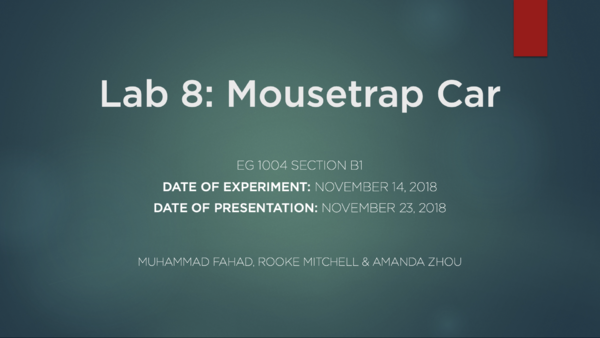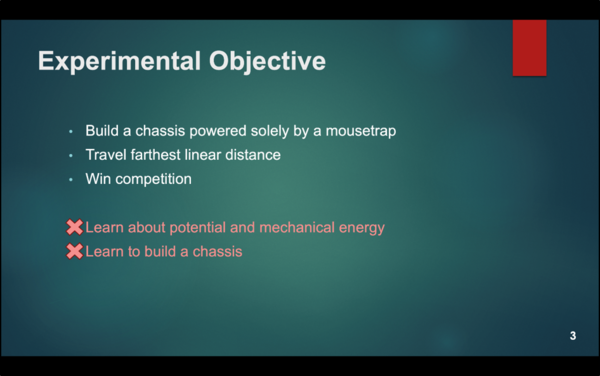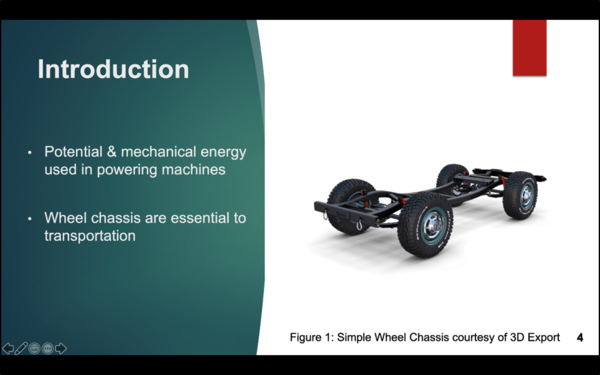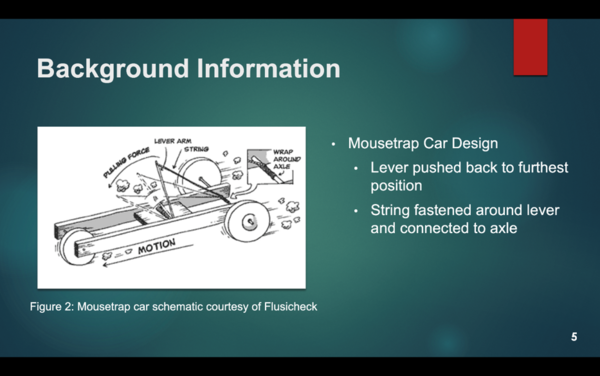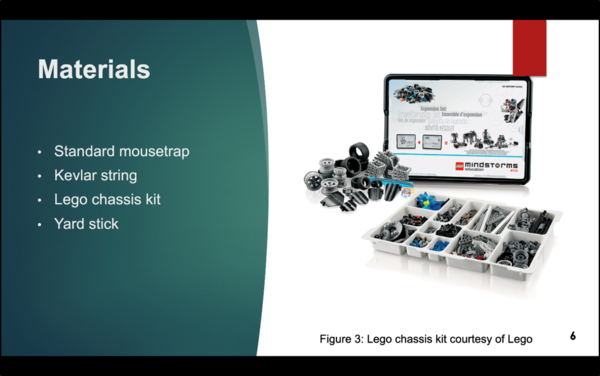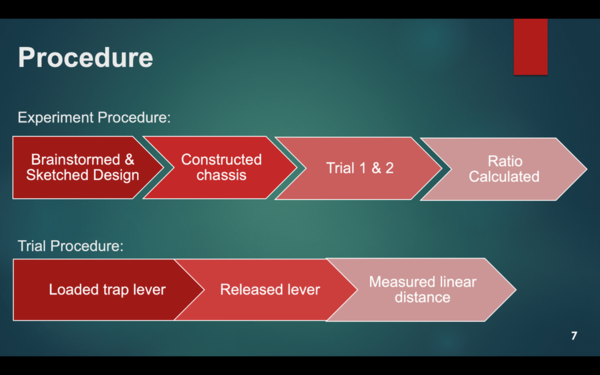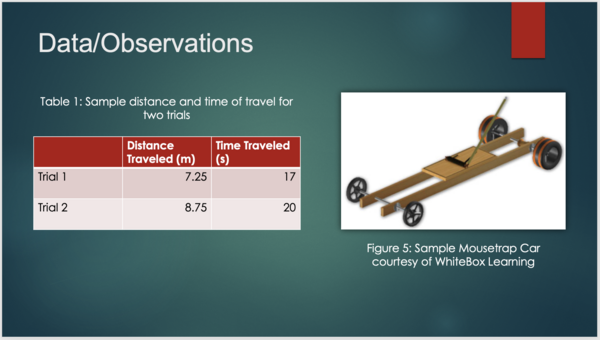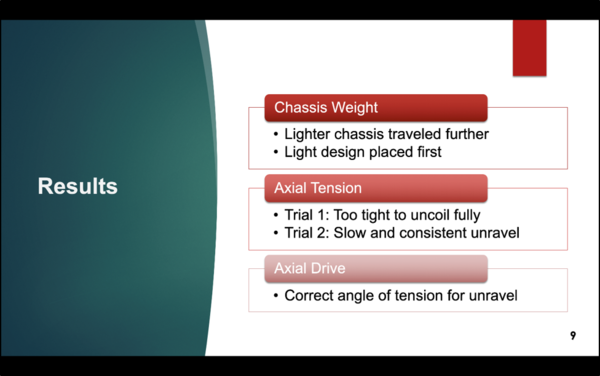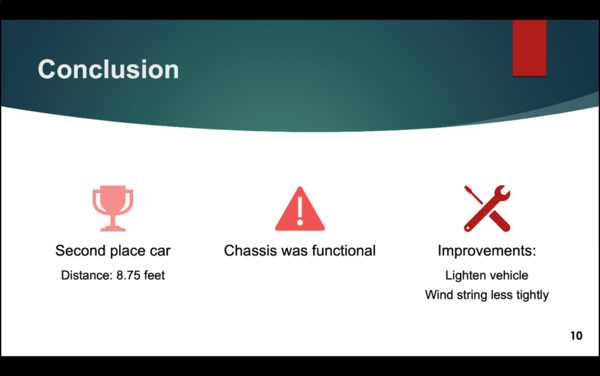Difference between revisions of "EG1004 Lab Presentation Format"
m |
|||
| (40 intermediate revisions by 5 users not shown) | |||
| Line 1: | Line 1: | ||
{{Outdated}} | |||
You will only have about five minutes to present your lab results, so it's important to | |||
only have a few slides and make them count. Each of the following subsections will describe | only have a few slides and make them count. Each of the following subsections will describe | ||
what each slide should contain. | what each slide should contain. | ||
= Title Slide = | |||
The title slide should have the following information: | |||
* The number and title of the lab | |||
* The course identification (EG1004) and your section | |||
* The date of the presentation itself | |||
* The names of the members of your group, in alphabetical order | |||
in | |||
[[Image:Title_slide.png|thumb|center|600px|Figure 1: Title Slide sample]] | |||
<p>When giving the presentation, the presenters should stand in the same order that their | <p>When giving the presentation, the presenters should stand in the same order that their | ||
names appear on the title slide to help the audience to know who is who. In EG1004, the | names appear on the title slide to help the audience to know who is who. In EG1004, the | ||
entire team | entire team should be presenting. </p> | ||
= Overview = | |||
Your overview slide should consist of the following list: | |||
<ul> | <ul> | ||
| Line 60: | Line 34: | ||
</ul> | </ul> | ||
<p> | [[Image:Overview.png|thumb|center|600px|Figure 2: Overview sample slide]] | ||
<p>You'll find that in EG1004 you can just "cut and paste" this slide from one presentation | |||
to the next.</p> | to the next.</p> | ||
<p>When giving the presentation, you | <p>When giving the presentation, you don't have to read over every item in the preceding list; pIt's usually sufficient to just say "These are the items we'll be covering today" wait a few seconds to allow the audience to read over the list, and then move on.</p> | ||
to just say | |||
audience to read over the list, and then move on.</p> | |||
<p>The remaining slides in the presentation will be the items in the list.</p> | <p>The remaining slides in the presentation will be the items in the list.</p> | ||
= Experimental Objective = | |||
<p>This slide describes what you tried to accomplish in this lab. The easiest way to | <p>This slide describes what you tried to accomplish in this lab. The easiest way to understand what this slide does is to picture yourself as a working professional and think of the lab as an assignment that you've been given. What is it that you're trying to accomplish? How would you define success?</p> | ||
understand what this slide does is to picture yourself as a working professional and think of | |||
the lab as an assignment that | |||
How would you define success?</p> | |||
<p>In some labs | <p>In some labs you'll be designing something, so your objective would be to come up with a working design. In other labs you'll be asked to analyze something and describe what it does, so in this case your objective would be to be successful in finding out what the object is, or how | ||
working design. In other labs | |||
in this case your objective would be to be successful in finding out what the object is, or how | |||
it works.</p> | it works.</p> | ||
<p>In most cases, the objective is stated early in the lab, so | <p>In most cases, the objective is stated early in the lab, so it's easy to find once you know | ||
how to look.</p> | how to look.</p> | ||
| Line 90: | Line 58: | ||
<p>One issue to be careful about is that the objectives are experimental objectives, not educational | <p>One issue to be careful about is that the objectives are experimental objectives, not educational | ||
objectives. Since | objectives. Since you're putting yourself in the role of a working professional, presumably you're | ||
competent to perform the task, or can learn how to be successful. Therefore, we measure success by | competent to perform the task, or can learn how to be successful. Therefore, we measure success by | ||
whether or not we were successful in our design, not in what we learned. Phrases you should avoid | whether or not we were successful in our design, not in what we learned. Phrases you should avoid | ||
for an objective would be | for an objective would be "to learn about", "to become familiar with", or similar phrases.</p> | ||
<p>Generally the objective can be stated in one or two bullets, and should answer the question of | <p>Generally the objective can be stated in one or two bullets, and should answer the question of | ||
"how do we define success?"</p> | |||
[[Image:Experimental_objective.png|thumb|center|600px|Figure 3: Experimental Objective sample slide]] | |||
= Introduction = | |||
<p>The labs cover a wide range of topics, so | <p>The labs cover a wide range of topics, so it's important to explain why this particular lab is | ||
important. There are two themes you can use here:</p> | important. There are two themes you can use here:</p> | ||
<ul> | <ul> | ||
<li>Why the technology | <li>Why the technology we're investigating is important to engineering practice or important to people.</li> | ||
<li>How this technology can be used to make our life easier.</li> | <li>How this technology can be used to make our life easier.</li> | ||
</ul> | </ul> | ||
<p>This information can also usually be found in the lab description if you know how to look. Read | <p>This information can also usually be found in the lab description if you know how to look. Read | ||
the lab carefully, think about why it was chosen, and | the lab carefully, think about why it was chosen, and you'll probably have more than enough material | ||
for this slide.</p> | for this slide.</p> | ||
[[Image:Introduction.png|thumb|center|600px|Figure 4: Introduction sample slide]] | |||
<p>At this point | = Background Information = | ||
<p>At this point you've given the audience enough material to get their attention. Now it's time | |||
to start explaining what you did and what you accomplished. The best model to use here is to | to start explaining what you did and what you accomplished. The best model to use here is to | ||
consider a lawyer building their case in court. When presenters make a claim, they have to back | consider a lawyer building their case in court. When presenters make a claim, they have to back | ||
it up with evidence, not just say to the audience | it up with evidence, not just say to the audience "trust me". This is where you start to present | ||
your evidence.</p> | your evidence.</p> | ||
| Line 127: | Line 99: | ||
<li>The relevant theories involved, as presented in the lab</li> | <li>The relevant theories involved, as presented in the lab</li> | ||
<li>The relevant equations used to calculate results and define success</li> | <li>The relevant equations used to calculate results and define success</li> | ||
<li>Competition rules (if it was a competition lab)</li> | |||
<li>Any pictures that help explain the principles involved, or how your design works</li> | <li>Any pictures that help explain the principles involved, or how your design works</li> | ||
<li>Real life applications that help demonstrate how your design is effective</li> | <li>Real life applications that help demonstrate how your design is effective</li> | ||
| Line 140: | Line 113: | ||
lab presentation. We try to make the lab interesting, so we explain things much more than you need | lab presentation. We try to make the lab interesting, so we explain things much more than you need | ||
to. The key word here is <b>RELEVANCE</b>. Make sure the material you include is relevant to your | to. The key word here is <b>RELEVANCE</b>. Make sure the material you include is relevant to your | ||
presentation, and not just everything | presentation, and not just everything that's in the lab description. Keep in mind that you only have | ||
about five minutes to present, and an exhaustive discussion of all the background information in the | about five minutes to present, and an exhaustive discussion of all the background information in the | ||
lab description will almost certainly cause you to run over on time, either leading to deductions in | lab description will almost certainly cause you to run over on time, either leading to deductions in | ||
| Line 149: | Line 122: | ||
might have trouble figuring out where to put certain material. Your faculty member and/or Recitation | might have trouble figuring out where to put certain material. Your faculty member and/or Recitation | ||
TA will point this out to you in your earlier presentations, until you get used to this format. Also, | TA will point this out to you in your earlier presentations, until you get used to this format. Also, | ||
an easy | an easy "rule of thumb" to use is to consider the material itself. If it's information you needed to | ||
successfully complete the lab, | successfully complete the lab, it's probably Background Information. If it's merely interesting | ||
material that adds interest to your presentation, it should probably go into the Introduction.</li> | material that adds interest to your presentation, it should probably go into the Introduction.</li> | ||
</ul> | </ul> | ||
| Line 157: | Line 130: | ||
section will probably consist of several slides.</p> | section will probably consist of several slides.</p> | ||
For competition labs, the rules of the competition must be stated in this section. | |||
[[Image: Background Information.png|thumb|center|600px|Figure 5: Background Information sample slide]] | |||
= Material = | |||
<p>This slide is easy. All you need to do is enumerate the materials you used as a bullet list | <p>This slide is easy. All you need to do is enumerate the materials you used as a bullet list.</p> | ||
<p>There are a few things to consider here. First, make sure you include only the materials you actually | <p>There are a few things to consider here. First, make sure you include only the materials you actually | ||
| Line 166: | Line 142: | ||
in completing your design. Our intent was to give you considerable flexibility in your design, and to | in completing your design. Our intent was to give you considerable flexibility in your design, and to | ||
insure that every team should come up with something unique. Therefore, you should only include the actual | insure that every team should come up with something unique. Therefore, you should only include the actual | ||
materials you used, not the complete list of the materials provided. Sometimes | materials you used, not the complete list of the materials provided. Sometimes you'll use some material | ||
and then discover you | and then discover you didn't need it in your final design. In this case the material should be included | ||
in the list, but note that it was later discarded.</p> | in the list, but note that it was later discarded.</p> | ||
| Line 174: | Line 150: | ||
LabVIEW®. In this case, these items should appear in the materials.</p> | LabVIEW®. In this case, these items should appear in the materials.</p> | ||
<p>Overall, the intent here is that if somebody wanted to duplicate | <p>Overall, the intent here is that if somebody wanted to duplicate what you did in the lab, this would | ||
be the list of what | be the list of what they'd need.</p> | ||
<p>One thing to be aware of: For your lab report, you should show your materials in a sentence. However, | <p>One thing to be aware of: For your lab report, you should show your materials in a sentence. However, | ||
in the presentation it should be a bullet list.</p> | in the presentation it should be a bullet list. Do not include competition cost tables. It's not required to read every material aloud but give the audience a few minutes to read the slide.</p> | ||
[[Image:Materials.png|thumb|center|600px|Figure 6: Materials sample slide]] | |||
= Procedure = | |||
<p>The main issue here is BREVITY! Keep in mind that you only have five minutes to do the entire | <p>This is where you describe what you did. You should describe the steps you followed. Use bullet points or flowcharts to explain the steps you followed.</p> | ||
<p>The main issue here is <b>BREVITY!</b> Keep in mind that you only have five minutes to do the entire | |||
presentation. An exhaustive description of every little step you did will easily cause you to run over | presentation. An exhaustive description of every little step you did will easily cause you to run over | ||
on time, costing you points on your grade and boring the audience. The lab descriptions are very | on time, costing you points on your grade and boring the audience. The lab descriptions are very | ||
detailed to help insure that | detailed to help insure that you'll be successful in completing the lab, but you should have <b>MUCH LESS</b> | ||
detail in your presentation.</p> | detail in your presentation.</p> | ||
<p>A good | <p>A good "rule of thumb" to use is to have the procedures be one slide, or two at most. More than that | ||
is too much detail. For some of the labs, it can be difficult to summarize a lot of work into so few items, | is too much detail. For some of the labs, it can be difficult to summarize a lot of work into so few items, | ||
but | but you'll be able to do it if you think about it. If you go over one slide, you should ask yourself if | ||
there really | there really isn't a way to summarize at a higher level.</p> | ||
<p>In addition to this list, you can also include pictures of the equipment you used if it helps the audience | <p>In addition to this list, you can also include pictures of the equipment you used if it helps the audience understand what you did.</p> | ||
understand what you did.</p> | |||
[[Image:Procedure.png|thumb|center|600px|Figure 7: Procedure sample slide]] | |||
= Data/Observations = | |||
<p>Our next task is to explain what we saw, which is what this section does. The important thing to | <p>At this point let's review what we've covered so far. We've defined what we're trying to accomplish | ||
understand here is that we are only reporting what we observed. Later on | (Objective). We've explained why it's important to do this (Introduction). We've given the "foundation" | ||
in the Background Information to derive results</p> | on which we will base our findings (Background Information). We've shown what we used to accomplish the | ||
goal (Materials). We've shown what we did to achieve the goal (Procedure).</p> | |||
<p>Our next task is to explain what we saw and present what we recorded, which is what this section does. The important thing to understand here is that we are <b>only reporting what we observed</b>. Later on we'll use the formulas we gave in the Background Information to derive results</p> | |||
<p>The primary issue here is to show what we saw in a way the audience can grasp quickly. Many of the labs | <p>The primary issue here is to show what we saw in a way the audience can grasp quickly. Many of the labs | ||
will have you take a number of readings. Therefore, the first way we can report our observations is by | will have you take a number of readings. Therefore, the first way we can report our observations is by | ||
using a table of the inputs we provided and the outputs observed. If there are a large number of values, | using a table (must have a title) of the inputs we provided and the outputs observed. If there are a large number of values, it will be hard to read the table just due to font size, and even if we could it will be hard for the audience to try to deduce a trend from the data you're showing. Therefore, it may be useful to have a chart of the data as well, especially if a large number of readings have been taken.</p> | ||
it will be hard to read the table just due to font size, and even if we could it will be hard for the | |||
audience to try to deduce a trend from the data | |||
of the data as well, especially if a large number of readings have been taken.</p> | |||
<p>If you’ve | <p>If you’ve designed something in CAD, it would be a good idea to present an image of the design in this section. Use captions and arrows to point out the special features on the image. If you’ve built a device, it would be a good idea to present an image of the design in this section. | ||
</p> | |||
special features on the | |||
<p>The main idea here is to present the raw data | <p>The main idea here is to present the raw data you recorded, without judgment or analysis. You are | ||
presenting additional facts which, when added to the preceding sections, continue to build your case.</p> | presenting additional facts which, when added to the preceding sections, continue to build your case.</p> | ||
| Line 227: | Line 199: | ||
allows the audience to get the message quickly. Remember that your time budget is only about 5 minutes.</p> | allows the audience to get the message quickly. Remember that your time budget is only about 5 minutes.</p> | ||
[[Image:dataobs.png|thumb|center|600px|Figure 8: Data/Observations sample slide]] | |||
= Results = | |||
<p>This is the section where you take the data presented in the preceding section and analyze it. In | <p>This is the section where you take the data presented in the preceding section and analyze it. In | ||
any cases | any cases you'll be applying the formulas you showed in the Background Information to the data given | ||
in the Observations to derive the results.</p> | in the Observations to derive the results.</p> | ||
<p> | <p>Refer to the data collected to support your results. This way you can easily defend the accuracy and honesty of your results.</p> | ||
can easily defend the accuracy and honesty of your results.</p> | |||
<p>Some of the labs are competitions. The competition judging is based on formulas given in the lab | <p>Some of the labs are competitions. The competition judging is based on formulas given in the lab | ||
description that you should have also included in your Background Information. Therefore, you can now | description that you should have also included in your Background Information. Show sample calculations. Therefore, you can now show the results of all the teams in your lab session and where you placed. This is usually a spreadsheet that your Lab TA will post to you. You can then include it in your presentation.</p> | ||
show the results of all the teams in your lab session and where you placed. This is usually a | |||
spreadsheet that your Lab TA will post to you. You can then include it in your presentation.</p> | |||
<p>You can now present some overall results. First, where did your team place in the competition? | <p>You can now present some overall results. First, where did your team place in the competition? | ||
| Line 248: | Line 219: | ||
this section, remember your time budget.</p> | this section, remember your time budget.</p> | ||
< | [[Image:Results.png|thumb|center|600px|Figure 9: Results sample slide]] | ||
= Conclusion = | |||
<p>In this section of the presentation you should discuss if the objective of the lab was achieved and suggest for improvements for your design or how you performed the lab. If it was a competition lab then state your teams place in the competition. </p> | |||
[[Image:Conclusion.png|thumb|center|600px|Figure 10: Conclusion sample slide]] | |||
<p>In many presentations, the conclusion is the most important slide of all. It is the last impression | <p>In many presentations, the conclusion is the most important slide of all. It is the last impression | ||
that | that you're going to give your audience, and it will probably be the way they will remember you. As an | ||
example, many viewers would agree that | example, many viewers would agree that "Star Wars III: Revenge of the Sith" was a good movie, primarily | ||
because of its special effects (a trademark of the entire Star Wars series). However, many of them | because of its special effects (a trademark of the entire Star Wars series). However, many of them | ||
hasten to add that they were disappointed by the last five minutes of the movie. | hasten to add that they were disappointed by the last five minutes of the movie. It's interesting that | ||
they give equal weight to the first two hours and fifteen minutes and the last five minutes of the | they give equal weight to the first two hours and fifteen minutes and the last five minutes of the | ||
movie.</p> | movie.</p> | ||
<p>You want to have impact on the audience with your conclusion. Above all, you want to make it look | <p>You want to have an impact on the audience with your conclusion. Above all, you want to make it look | ||
like you were successful, even if you | like you were successful, even if you weren't. After the Challenger disaster in 1986, NASA held a | ||
press conference to discuss one of the darkest days in the US space effort. Many people felt it could | press conference to discuss one of the darkest days in the US space effort. Many people felt it could | ||
be a disaster from which NASA would never recover, and that the US space program was essentially dead. | be a disaster from which NASA would never recover, and that the US space program was essentially dead. | ||
At the press conference, a reporter asked a NASA representative what they planned to do about this | At the press conference, a reporter asked a NASA representative what they planned to do about this | ||
colossal failure. The representative, without hesitation, said that NASA never had a failure – an | colossal failure. The representative, without hesitation, said that NASA never had a failure – an | ||
answer that certainly surprised everybody in the room. The representative then explained that | answer that certainly surprised everybody in the room. The representative then explained that NASA's | ||
mission was essentially gathering knowledge for the benefit of humanity. They viewed the Challenger | mission was essentially gathering knowledge for the benefit of humanity. They viewed the Challenger | ||
incident, although extremely painful, as a learning experience. They would fully investigate what went | incident, although extremely painful, as a learning experience. They would fully investigate what went | ||
| Line 272: | Line 249: | ||
<p>First, if you achieved the objective, say so. Note that the objectives given in the lab description | <p>First, if you achieved the objective, say so. Note that the objectives given in the lab description | ||
are usually fairly general by intent, so you can usually | are usually fairly general by intent, so you can usually "spin" the objective to one which is favorable | ||
to whatever you achieved. This should be reflected in your | to whatever you achieved. This should be reflected in your "Objective" slide at the beginning of the | ||
presentation. Sometimes, however, even this is not enough. In that case, you can restate the objective | presentation. Sometimes, however, even this is not enough. In that case, you can restate the objective | ||
at the conclusion in a way that at least minimizes the damage.</p> | at the conclusion in a way that at least minimizes the damage.</p> | ||
<p>If the lab was a competition and your team won, be sure to say so! Brag! You deserve it! If you | <p>If the lab was a competition and your team won, be sure to say so! Brag! You deserve it! If you | ||
almost won, you can point that out and still claim success. If you came in | almost won, you can point that out and still claim success. If you came in "in the pack" or at the | ||
bottom, you can still claim that you were partially successful by submitting a design.</p> | bottom, you can still claim that you were partially successful by submitting a design.</p> | ||
<p>One word that you should never use: Failure. Remember the NASA story several paragraphs ago, and | <p>One word that you should never use: Failure. Remember the NASA story several paragraphs ago, and | ||
learn from it. Failures are created by losers, and you | learn from it. Failures are created by losers, and you don't want the audience to see you as a loser. | ||
Therefore, you can just note a lack of total success | Therefore, you can just note a lack of total success. In industry, even if you won a competition, there will probably be a review of how to improve the design. Your competition, who did not win, will improve their designs for next time, and if you don't, you'll become | ||
even if you won a competition, there will probably be a review of how to improve the design. Your | |||
competition, who did not win, will improve their designs for next time, and if you | |||
noncompetitive.</p> | noncompetitive.</p> | ||
= Critique = | |||
<p>After your team has given its presentation, | <p>After your team has given its presentation, your Professor, Writing Professor and Recitation TA will probably go over it with you to show where it can be improved. The <b>first several reviews will probably be extensive</b> since you are not used to giving presentations. However, as the term progresses you'll | ||
go over it with you to show where it can be improved. The first several reviews will probably be | find that you've made significant progress and the reviews will be much shorter.</p> | ||
extensive since you are not used to giving presentations. However, as the term progresses | |||
find that | |||
<p>During the comments, you will remain up front at the screen. After the | <p>During the comments, you will remain up front at the screen. After the comments are completed, you can return to your seat. It is a tradition that as the team returns to their seat, the class gives them a round of applause to show that they appreciate their efforts.</P> | ||
comments are completed, you can return to your seat. It is a tradition that | |||
as the team returns to their seat, the class gives them a round of applause to | |||
show that they appreciate their efforts.</P> | |||
<p>The most important issue there is that every team learns from every other | <p>The most important issue there is that every team learns from every other team. If your team is presenting, the comments will give you valuable guidance. If you're not presenting, you can see good ideas that other teams used, and that you can take advantage of in future presentations. You can also hear the | ||
team. If your team is presenting, the comments will give you valuable guidance. | |||
If you're not presenting, you can see good ideas that other teams used, and | |||
that you can take advantage of in future presentations. You can also hear the | |||
faculty comments and avoid making these mistakes yourself in the future.</p> | faculty comments and avoid making these mistakes yourself in the future.</p> | ||
<h2>Hardcopy</h2> | = Presentation Tips = | ||
<p>Use bullet points and avoid using complete sentences. Think about how you’ll transition from topic to topic in advance. Use a storytelling technique to provide the best presentation. Be sure to include the motivation behind the experiment/project and important foundational concepts. All media used in the presentation must have captions! | |||
[[ File:Caption.PNG|thumb|center|600px|Figure 11: Example of a Captioned Image]] | |||
Include images from lab but <b>do not include images of any hand-drawn lab notes</b>. Make sure that the font used and text sizes are consistent. Always think about how the font and text size would look on a bigger screen. Avoid using serif fonts and add a slide number to every slide. To avoid overcrowding the slide, only add main points on the slide and focus on elaborating them verbally. If you make a mistake stay calm and continue presenting. Remember that only you know what you actually had to say so the best thing to do is to continue presenting! Eye contact with the audience is very important to keep them engaged.</p> | |||
<!--<h2>Hardcopy (In-Person Classes Only)</h2> | |||
<p>At the start of the recitation, your Recitation TA will collect a printed version of your | <p>At the start of the recitation, your Recitation TA will collect a printed version of your | ||
presentation from your team. There is only one submission per team. When you print the presentation | presentation from your team. There is only one submission per team. When you print the presentation | ||
from PowerPoint, be sure to select | from PowerPoint, be sure to select "Handouts" under "Print what", with 6 slides per page, vertical | ||
order (these are the defaults for handouts). Under | order (these are the defaults for handouts). Make sure to ask your recitation TA about the order for the handout. Under "Color/Grayscale", select "Pure black and white". | ||
Then select | Then select "OK" to print the presentation. After the presentation is printed, you should staple the | ||
pages together in preparation for turning the presentation in.</p> | pages together in preparation for turning the presentation in.</p> | ||
<p>You now see another reason for the title slide: it identifies your presentation for grading purposes. | <p>You now see another reason for the title slide: it identifies your presentation for grading purposes. | ||
After the presentation has been graded, your Recitation TA will return your hardcopy back to your team, | After the presentation has been graded, your Recitation TA will return your hardcopy back to your team, | ||
usually with additional commentary on how you can improve the presentation.</p> | usually with additional commentary on how you can improve the presentation.</p>--> | ||
<!--<p>[[Main_Page | Return to Table of Contents]]</p> | |||
<p>[[EG1004 Project Milestone Presentation Format | Continue to next topic: EG1004 Project Milestone Presentation Format]]</p> | |||
[[ | <p>[[Blunders to Avoid | Continue to previous topic: Blunders to Avoid]]</p>--> | ||
Latest revision as of 18:38, 1 October 2025
| This page's accuracy may be compromised because of out-of-date information. The information displayed on this page has been deprecated and is kept for historical purposes only. There may or may not be information relevant to the current course curriculum. |
You will only have about five minutes to present your lab results, so it's important to only have a few slides and make them count. Each of the following subsections will describe what each slide should contain.
Title Slide
The title slide should have the following information:
- The number and title of the lab
- The course identification (EG1004) and your section
- The date of the presentation itself
- The names of the members of your group, in alphabetical order
When giving the presentation, the presenters should stand in the same order that their names appear on the title slide to help the audience to know who is who. In EG1004, the entire team should be presenting.
Overview
Your overview slide should consist of the following list:
- Experimental Objective
- Introduction
- Background Information
- Materials
- Procedure
- Data/Observations
- Results
- Conclusion
You'll find that in EG1004 you can just "cut and paste" this slide from one presentation to the next.
When giving the presentation, you don't have to read over every item in the preceding list; pIt's usually sufficient to just say "These are the items we'll be covering today" wait a few seconds to allow the audience to read over the list, and then move on.
The remaining slides in the presentation will be the items in the list.
Experimental Objective
This slide describes what you tried to accomplish in this lab. The easiest way to understand what this slide does is to picture yourself as a working professional and think of the lab as an assignment that you've been given. What is it that you're trying to accomplish? How would you define success?
In some labs you'll be designing something, so your objective would be to come up with a working design. In other labs you'll be asked to analyze something and describe what it does, so in this case your objective would be to be successful in finding out what the object is, or how it works.
In most cases, the objective is stated early in the lab, so it's easy to find once you know how to look.
Some of the labs are competitions, so an obvious additional objective for these labs would be to win the competition. Everybody wants to win a contest, making this a goal. Nobody wants to lose a contest.
One issue to be careful about is that the objectives are experimental objectives, not educational objectives. Since you're putting yourself in the role of a working professional, presumably you're competent to perform the task, or can learn how to be successful. Therefore, we measure success by whether or not we were successful in our design, not in what we learned. Phrases you should avoid for an objective would be "to learn about", "to become familiar with", or similar phrases.
Generally the objective can be stated in one or two bullets, and should answer the question of "how do we define success?"
Introduction
The labs cover a wide range of topics, so it's important to explain why this particular lab is important. There are two themes you can use here:
- Why the technology we're investigating is important to engineering practice or important to people.
- How this technology can be used to make our life easier.
This information can also usually be found in the lab description if you know how to look. Read the lab carefully, think about why it was chosen, and you'll probably have more than enough material for this slide.
Background Information
At this point you've given the audience enough material to get their attention. Now it's time to start explaining what you did and what you accomplished. The best model to use here is to consider a lawyer building their case in court. When presenters make a claim, they have to back it up with evidence, not just say to the audience "trust me". This is where you start to present your evidence.
The idea here is to start building your case by making a foundation of the relevant facts and principles that you used in the lab to achieve success. This information can take several forms:
- The background technology on which the lab is based
- The relevant theories involved, as presented in the lab
- The relevant equations used to calculate results and define success
- Competition rules (if it was a competition lab)
- Any pictures that help explain the principles involved, or how your design works
- Real life applications that help demonstrate how your design is effective
Once again, you can find all this material in the lab description if you read it carefully. All you need to do is extract it intelligently.
There are several issues to watch carefully here:
- Usually the lab description gives you much more background information than you need for the lab presentation. We try to make the lab interesting, so we explain things much more than you need to. The key word here is RELEVANCE. Make sure the material you include is relevant to your presentation, and not just everything that's in the lab description. Keep in mind that you only have about five minutes to present, and an exhaustive discussion of all the background information in the lab description will almost certainly cause you to run over on time, either leading to deductions in lack of presentation skills by staying within the allotted time, or boring the audience with a bunch of irrelevant material.
- The difference between the Introduction and Background Information can be subtle at times. You might have trouble figuring out where to put certain material. Your faculty member and/or Recitation TA will point this out to you in your earlier presentations, until you get used to this format. Also, an easy "rule of thumb" to use is to consider the material itself. If it's information you needed to successfully complete the lab, it's probably Background Information. If it's merely interesting material that adds interest to your presentation, it should probably go into the Introduction.
This is the first section that may consist of more than one slide. In fact, in the later labs, this section will probably consist of several slides.
For competition labs, the rules of the competition must be stated in this section.
Material
This slide is easy. All you need to do is enumerate the materials you used as a bullet list.
There are a few things to consider here. First, make sure you include only the materials you actually used. Many of the labs, especially the competitions, include a great deal of material to choose from in completing your design. Our intent was to give you considerable flexibility in your design, and to insure that every team should come up with something unique. Therefore, you should only include the actual materials you used, not the complete list of the materials provided. Sometimes you'll use some material and then discover you didn't need it in your final design. In this case the material should be included in the list, but note that it was later discarded.
Next, make sure your list is complete. Sometimes a material is so obvious that you forget to include it. For example, many of the labs make use of the lab PC and some software called LabVIEW®. In this case, these items should appear in the materials.
Overall, the intent here is that if somebody wanted to duplicate what you did in the lab, this would be the list of what they'd need.
One thing to be aware of: For your lab report, you should show your materials in a sentence. However, in the presentation it should be a bullet list. Do not include competition cost tables. It's not required to read every material aloud but give the audience a few minutes to read the slide.
Procedure
This is where you describe what you did. You should describe the steps you followed. Use bullet points or flowcharts to explain the steps you followed.
The main issue here is BREVITY! Keep in mind that you only have five minutes to do the entire presentation. An exhaustive description of every little step you did will easily cause you to run over on time, costing you points on your grade and boring the audience. The lab descriptions are very detailed to help insure that you'll be successful in completing the lab, but you should have MUCH LESS detail in your presentation.
A good "rule of thumb" to use is to have the procedures be one slide, or two at most. More than that is too much detail. For some of the labs, it can be difficult to summarize a lot of work into so few items, but you'll be able to do it if you think about it. If you go over one slide, you should ask yourself if there really isn't a way to summarize at a higher level.
In addition to this list, you can also include pictures of the equipment you used if it helps the audience understand what you did.
Data/Observations
At this point let's review what we've covered so far. We've defined what we're trying to accomplish (Objective). We've explained why it's important to do this (Introduction). We've given the "foundation" on which we will base our findings (Background Information). We've shown what we used to accomplish the goal (Materials). We've shown what we did to achieve the goal (Procedure).
Our next task is to explain what we saw and present what we recorded, which is what this section does. The important thing to understand here is that we are only reporting what we observed. Later on we'll use the formulas we gave in the Background Information to derive results
The primary issue here is to show what we saw in a way the audience can grasp quickly. Many of the labs will have you take a number of readings. Therefore, the first way we can report our observations is by using a table (must have a title) of the inputs we provided and the outputs observed. If there are a large number of values, it will be hard to read the table just due to font size, and even if we could it will be hard for the audience to try to deduce a trend from the data you're showing. Therefore, it may be useful to have a chart of the data as well, especially if a large number of readings have been taken.
If you’ve designed something in CAD, it would be a good idea to present an image of the design in this section. Use captions and arrows to point out the special features on the image. If you’ve built a device, it would be a good idea to present an image of the design in this section.
The main idea here is to present the raw data you recorded, without judgment or analysis. You are presenting additional facts which, when added to the preceding sections, continue to build your case.
This section is usually several slides. The main problem here is to present your data in a way that allows the audience to get the message quickly. Remember that your time budget is only about 5 minutes.
Results
This is the section where you take the data presented in the preceding section and analyze it. In any cases you'll be applying the formulas you showed in the Background Information to the data given in the Observations to derive the results.
Refer to the data collected to support your results. This way you can easily defend the accuracy and honesty of your results.
Some of the labs are competitions. The competition judging is based on formulas given in the lab description that you should have also included in your Background Information. Show sample calculations. Therefore, you can now show the results of all the teams in your lab session and where you placed. This is usually a spreadsheet that your Lab TA will post to you. You can then include it in your presentation.
You can now present some overall results. First, where did your team place in the competition? Did you achieve the objective you described at the beginning of the presentation? If so, why? If not, why not?
In general, your results will only be one or two slides. If you want more slides than this for this section, remember your time budget.
Conclusion
In this section of the presentation you should discuss if the objective of the lab was achieved and suggest for improvements for your design or how you performed the lab. If it was a competition lab then state your teams place in the competition.
In many presentations, the conclusion is the most important slide of all. It is the last impression that you're going to give your audience, and it will probably be the way they will remember you. As an example, many viewers would agree that "Star Wars III: Revenge of the Sith" was a good movie, primarily because of its special effects (a trademark of the entire Star Wars series). However, many of them hasten to add that they were disappointed by the last five minutes of the movie. It's interesting that they give equal weight to the first two hours and fifteen minutes and the last five minutes of the movie.
You want to have an impact on the audience with your conclusion. Above all, you want to make it look like you were successful, even if you weren't. After the Challenger disaster in 1986, NASA held a press conference to discuss one of the darkest days in the US space effort. Many people felt it could be a disaster from which NASA would never recover, and that the US space program was essentially dead. At the press conference, a reporter asked a NASA representative what they planned to do about this colossal failure. The representative, without hesitation, said that NASA never had a failure – an answer that certainly surprised everybody in the room. The representative then explained that NASA's mission was essentially gathering knowledge for the benefit of humanity. They viewed the Challenger incident, although extremely painful, as a learning experience. They would fully investigate what went wrong, fix it, and insure that it would not happen again on future designs. Although it was a bitter way to gain knowledge, this would result in better, safer Space Shuttles. Everyone present felt this was a powerful answer to a very difficult question.
First, if you achieved the objective, say so. Note that the objectives given in the lab description are usually fairly general by intent, so you can usually "spin" the objective to one which is favorable to whatever you achieved. This should be reflected in your "Objective" slide at the beginning of the presentation. Sometimes, however, even this is not enough. In that case, you can restate the objective at the conclusion in a way that at least minimizes the damage.
If the lab was a competition and your team won, be sure to say so! Brag! You deserve it! If you almost won, you can point that out and still claim success. If you came in "in the pack" or at the bottom, you can still claim that you were partially successful by submitting a design.
One word that you should never use: Failure. Remember the NASA story several paragraphs ago, and learn from it. Failures are created by losers, and you don't want the audience to see you as a loser. Therefore, you can just note a lack of total success. In industry, even if you won a competition, there will probably be a review of how to improve the design. Your competition, who did not win, will improve their designs for next time, and if you don't, you'll become noncompetitive.
Critique
After your team has given its presentation, your Professor, Writing Professor and Recitation TA will probably go over it with you to show where it can be improved. The first several reviews will probably be extensive since you are not used to giving presentations. However, as the term progresses you'll find that you've made significant progress and the reviews will be much shorter.
During the comments, you will remain up front at the screen. After the comments are completed, you can return to your seat. It is a tradition that as the team returns to their seat, the class gives them a round of applause to show that they appreciate their efforts.
The most important issue there is that every team learns from every other team. If your team is presenting, the comments will give you valuable guidance. If you're not presenting, you can see good ideas that other teams used, and that you can take advantage of in future presentations. You can also hear the faculty comments and avoid making these mistakes yourself in the future.
Presentation Tips
Use bullet points and avoid using complete sentences. Think about how you’ll transition from topic to topic in advance. Use a storytelling technique to provide the best presentation. Be sure to include the motivation behind the experiment/project and important foundational concepts. All media used in the presentation must have captions!
Include images from lab but do not include images of any hand-drawn lab notes. Make sure that the font used and text sizes are consistent. Always think about how the font and text size would look on a bigger screen. Avoid using serif fonts and add a slide number to every slide. To avoid overcrowding the slide, only add main points on the slide and focus on elaborating them verbally. If you make a mistake stay calm and continue presenting. Remember that only you know what you actually had to say so the best thing to do is to continue presenting! Eye contact with the audience is very important to keep them engaged.
